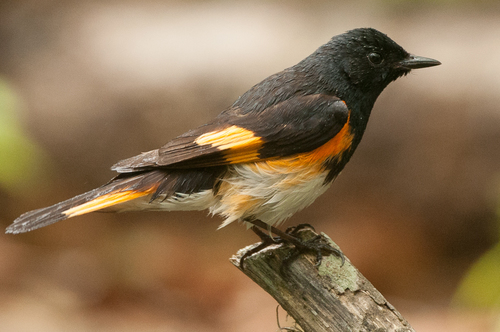
American Redstart
The American Redstart (Setophaga ruticilla) is a vibrant and active warbler known for its striking plumage and energetic foraging behavior. Often described as a "butterfly of the bird world," the male's black and orange coloration is instantly recognizable. This small songbird plays a crucial role in controlling insect populations within its forest habitats. Beyond its ecological importance, the American Redstart holds a degree of cultural significance, often appearing in folklore and nature writing as a symbol of vitality and the changing seasons. It is a common sight in many North American woodlands during the breeding season.
11-14 cm
Length
16-23 cm
Wingspan
Least Concern
Conservation Status
Distribution
The American Redstart breeds across a wide range of North America, from southeastern Alaska and central Canada south to the central and eastern United States. It winters in Central America, the Caribbean, and northern South America. Migratory routes are extensive, with birds funneling through the eastern and central US.
Lifespan
Up to 10 years in the wild, but typically shorter; average lifespan is not well-documented.
American Redstart's Habitat
Habitat Types
Deciduous forests, Mixed woodlands, Forest edges, Riparian areas, Secondary growth forests
Climate Zones
Temperate, Boreal, Tropical (during winter)
Adaptations
The American Redstart's agility and slender bill are adaptations for catching insects in flight and gleaning them from foliage. Its preference for open understory allows for efficient aerial maneuvering.
Variations
While several subspecies have been proposed, there is limited significant regional variation in plumage or morphology.
Appearance
Breeding Plumage
Adult males in breeding plumage are black above with bright orange patches on the sides, wings, and tail. Females and immature males are grayish-olive above with yellow patches. Non-breeding males resemble females but may show some black feathers.
Seasonal Feather Changes
Some seasonal variation occurs, with breeding plumage being the most distinct. Molting occurs after the breeding season.
Sex Based Plumage Differences
Strong sexual dimorphism; males are much more brightly colored than females.
Notable Features
Bright orange or yellow patches on wings and tail, Constantly fans tail and droops wings while foraging, Slender, pointed bill
Diet and Feeding
Primary Foods
Insects, Spiders, Other small invertebrates, Berries (occasionally)
Foraging Behavior
American Redstarts are active foragers, often seen flitting through foliage and making short flights to catch insects in mid-air (flycatching). They also glean insects from leaves and branches.
Specializations
Their agility and quick movements are specializations for capturing flying insects. The 'flashing' of their colorful tail and wing patches may startle insects into flight, making them easier to catch.
Seasonal Diet Variations
Primarily insectivorous during the breeding season. May consume more berries and fruits during migration and in winter when insects are less abundant.
Behavior
Social Structure
Generally solitary or in pairs during the breeding season. May form loose flocks during migration.
Communication
High-pitched, thin songs, Chip calls, Visual displays (tail fanning, wing drooping)
Migration
Long-distance migrant. Travels at night, often in mixed-species flocks. Migrates to Central and South America for the winter.
Territorial or Group Behaviors
Males are highly territorial during the breeding season, defending their territories through song and aggressive displays.
Conservation
Threats
Habitat loss and fragmentation (both breeding and wintering grounds), Collisions with buildings and other structures, Pesticide use (reducing insect prey), Climate change (potential shifts in habitat and food availability)
Protection Programs
Conservation of forest habitats, Efforts to reduce pesticide use, Bird-friendly building initiatives
Local National Laws
Protected under the Migratory Bird Treaty Act in the United States and Canada.
Population Trend
Stable
Population Estimates
Global population estimated at 24 million individuals.
Interesting Facts
American Redstarts are known for their "flash-and-dash" foraging style.
They frequently fan their tails and droop their wings, possibly to startle insects into moving, making them easier to catch.
Young males resemble females for their first year.
This delayed plumage maturation may help them avoid aggression from older males.
They are one of the few warbler species with such strong sexual dimorphism.
The contrasting colors of the male are thought to play a role in both attracting mates and defending territory.
Faqs about American Redstart
What do American Redstarts eat?
They primarily eat insects, spiders, and other small invertebrates. They may also eat berries, especially during migration.
Where do American Redstarts nest?
They build cup-shaped nests in the forks of trees or shrubs, usually in deciduous or mixed forests.
Are American Redstarts endangered?
No, they are classified as Least Concern by the IUCN, meaning they are not currently facing a high risk of extinction.
How can I attract American Redstarts to my yard?
Planting native trees and shrubs that attract insects can provide food and habitat. Providing a water source, like a bird bath, can also be helpful. Avoid using pesticides.
Copyright @ Nature Style Limited. All Rights Reserved.
 English
English